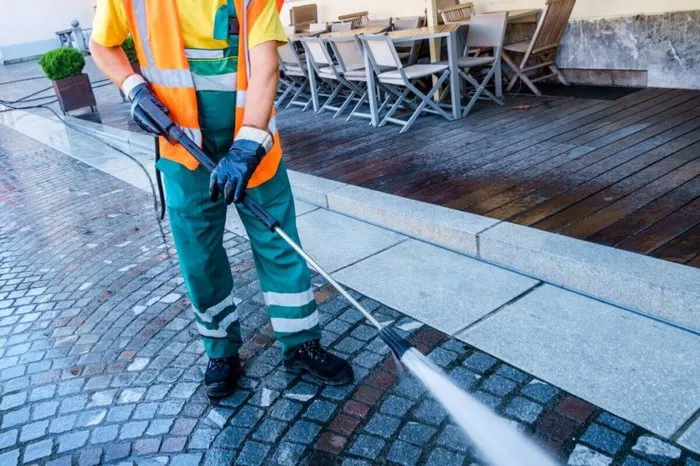Pressure washers have revolutionized the way we clean our homes, offering a powerful and efficient method for maintaining the exterior. These machines, which utilize high-pressure water spray, can quickly remove dirt, grime, mold, and mildew, restoring the aesthetic appeal of your house. However, while pressure washers are incredibly effective, improper use can lead to damage rather than improvement. This guide will help you determine if pressure washing is suitable for your home’s exterior and provide essential tips for safe and effective cleaning.
Is a Pressure Washer Right for Your House?
Pressure washers are versatile tools, but not all exterior surfaces are equally suitable for this cleaning method. The key lies in understanding your house’s siding material and the pressure washer’s specifications.
Siding Materials and Suitability
1. Vinyl Siding Vinyl is one of the most pressure washer-friendly materials. It can withstand moderate pressure without damage, making it an excellent candidate for pressure washing. However, excessive pressure can cause the vinyl to crack or loosen, so it’s crucial to use a lower PSI setting.
2. Wood Siding Wood siding requires a more delicate approach. High pressure can strip away paint and damage the wood fibers, leading to splintering and increased vulnerability to water damage. For wood siding, use a lower PSI and a wider spray pattern to minimize impact.
3. Stucco Stucco is a more fragile material and can be easily damaged by high-pressure washing. The texture of stucco can trap dirt, making it challenging to clean. When using a pressure washer on stucco, it’s vital to use a lower PSI and a broader spray to prevent chipping or cracking.
4. Brick Brick is robust and can typically handle higher pressure, but the mortar between bricks is susceptible to damage. For brick surfaces, it’s essential to use a moderate PSI and ensure the spray does not focus too intensely on the mortar lines.
Checking the PSI Rating and Choosing the Right Tip
The effectiveness and safety of pressure washing largely depend on the PSI rating of the machine and the type of nozzle used.
1. PSI Rating The PSI rating indicates the pressure level the washer can produce. For most house exteriors, a PSI between 1,500 and 2,500 is sufficient. Higher PSI ratings might be necessary for particularly stubborn stains or more durable surfaces like concrete.
2. Nozzle Tips Pressure washers come with various nozzle tips, each designed for different applications. The tips are color-coded for easy identification:
Red (0 degrees): Produces a pinpoint jet stream; used for tough stains but can cause damage if not used carefully.
Yellow (15 degrees): Provides a narrow, high-pressure spray; suitable for concrete and metal.
Green (25 degrees): Offers a medium-pressure spray; ideal for general cleaning tasks.
White (40 degrees): Delivers a wide spray; safe for most surfaces, including vinyl and wood.
Black (65 degrees): Low-pressure tip; typically used for applying soap or detergent.
See also: Power Washing Service Costs: A Guide for Homeowners
Safety Precautions
Pressure washers are powerful tools that require careful handling to ensure safety and prevent damage.
Protective Gear
1. Eye Protection: Safety goggles are essential to protect your eyes from flying debris and water spray.
2. Gloves: Protect your hands from high-pressure water jets and cleaning chemicals.
3. Long Pants and Closed-Toe Shoes: These protect your legs and feet from accidental sprays and debris.
Safe Operation Practices
1. Maintain Distance: Always keep a safe distance between the nozzle and the surface you’re cleaning. Typically, 6 to 12 inches is sufficient to avoid damage.
2. Use a Sweeping Motion: Move the nozzle in a side-to-side sweeping motion. This prevents focusing too much pressure on one spot, which can cause damage.
3. Check for Damage: Inspect the exterior for loose paint, damaged siding, or other vulnerabilities before starting. Address these issues to prevent exacerbating them during cleaning.
Pressure Washing Techniques
Proper technique is crucial for effective and safe pressure washing.
Preparing the Area
1. Cover Plants and Furniture: Use tarps or plastic sheets to protect plants, outdoor furniture, and other items from high-pressure spray and cleaning chemicals.
2. Close Windows and Doors: Ensure all windows and doors are securely closed to prevent water from entering the house.
Using Detergent
1. Detergent Solution: For stubborn grime, mold, or mildew, use a detergent designed for pressure washers. Apply the detergent using a low-pressure soap tip and let it sit for 5-10 minutes to break down dirt.
2. Rinsing: After applying detergent, switch to a higher-pressure nozzle to rinse away the solution and dirt. Ensure thorough rinsing to prevent detergent residue.
Spray Patterns
1. Wide Spray (40 degrees): Use this pattern for delicate surfaces or initial rinsing. It covers a larger area with less pressure.
2. Narrow Spray (15-25 degrees): Ideal for tougher cleaning tasks and more resilient surfaces. It provides more concentrated pressure for removing stubborn dirt.
See also: How Much PSI Do I Need to Pressure Wash Concrete?
Alternatives to Pressure Washing
Not all surfaces are suitable for pressure washing, and sometimes alternative methods are preferable.
1. Soft Washing Soft washing is a gentler method that uses low-pressure water combined with specialized cleaning solutions. It is particularly effective for delicate surfaces like wood siding, roofs, and painted surfaces. This method minimizes the risk of damage while effectively cleaning the exterior.
2. Manual Cleaning For areas that are too fragile for even soft washing, manual cleaning with a brush and mild detergent can be the safest option. This method is labor-intensive but ensures thorough cleaning without the risk of high-pressure damage.
Conclusion
Pressure washing can be a highly effective way to clean the exterior of your home, but it requires careful consideration of your siding material, appropriate equipment settings, and proper techniques to avoid damage. For complex or high-rise buildings, or if you’re unsure about the best approach, consulting a professional can ensure the job is done safely and effectively. Pressure washing, when done correctly, can significantly enhance the appearance and longevity of your home’s exterior.

